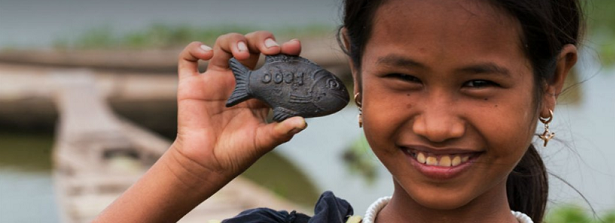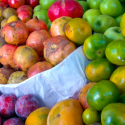A lucky iron fish for everyone?

What can be done to support the consumption of more healthy food products by the poorest people in low- and middle-income countries, the people at the so-called “Bottom of the Pyramid” (BoP)? That is an urgent challenge, given the fact that globally 155 million children are still stunted, 52 million children are wasted, and 2 billion people lack key nutrients like iron and vitamin A1. This challenge is addressed by several actors in these countries and their international partners. Small, medium and larger enterprises from different sectors are those who use market-based solutions to produce, distribute and sell nutritious food products to consumers. In addition, NGOs and the public sector also contribute to tackling the different forms of malnutrition, including in countries with emergencies.
An event in Utrecht, the Netherlands, on October 4, 2018, facilitated by BoP Innovation Center (BoPInc) brought several of these stakeholders together and provided participants with updates on the nutrition approaches of companies such as Unilever and Arla DK, and of the international NGO Save the Children2. Inspiring and interactive work sessions took place in which participants were asked to reflect on the business models and feasibility of some of the business solutions to tackle malnutrition; and to generate “wacky” solutions for the core nutrition obstacles of particular groups belonging to the poorest socio-economic groups in for example Nigeria or Bangladesh.
Micro-entrepreneurs develop retail business
It became evident that there is no silver bullet for nutritious foods’ distribution; a variety of channels is needed to facilitate the better availability of nutritious products: existing channels, hybrid models and direct channels all have their roles and merits. One of the challenges discussed was that often in remote rural areas, where there are millions of potential consumers, there is no retail distribution network. The direct-to-consumer retail models used by bigger companies interested to sell their innovative product to (new) BoP consumer markets have been successful in several cases. Many local retailers with whom they collaborate have succeeded in building a business too, which meant these micro-entrepreneurs have developed an income for themselves while also serving the needs of consumers to access particular nutritious foods. The Shakti project for example, implemented by Unilever and partners in Asia and Africa, now offers employment to over 77,000 women entrepreneurs.
A challenge in this direct-to-consumer retail distribution model is the cost of nutrition education messaging. It is often effectively integrated in the services, but in some cases the profitability of the retailing business was hindered by the implicit costs of the (unpaid) behavior change messaging services. Discussants agreed that lasting behavior change takes time, particularly when complex health behaviors are at stake. They see the public sector or NGOs always need to play a role, as businesses cannot be held responsible for all behavioral change ambitions. It is about public goods that require a public effort and investment.
Another challenge discussed was on how to further increase the success of the small entrepreneurs’ business models of the “last mile distribution” of nutritious food. One option would be to develop baskets of products that one small retailer offers; the products with a good margin could serve as the basis for the small business owner, while some more nutritious products with a smaller margin could then also be included and offered to the clients. Another solution area mentioned was whether the pricing of the products could work as incentive for positive nutritious choices, for example through VAT exemptions for the healthier products.
Nutritious snacks and water at the rickshaw fuel station
The participants also brainstormed about innovative solutions for core nutrition obstacles. BoPInc showed a “lucky iron fish” as an example of a simple-to-use small iron cooking tool that helps prevent iron deficiency. The innovation model used by BoP Inc was used to reflect on “wacky” options, with a quick scan of the poor consumer’s needs and interests as starting point. Wacky options could be anything that came to the mind of the participants, who were inspired by the method to write a range of out-of-the-box ideas on yellow post-its and to join lively conversations on how to put that together in practice. A well appreciated idea was a rickshaw fuel station, which would also offer fresh water, nutritious snacks, as well as childcare facilities and a cash point; in order to meet several pressing needs of urban rickshaw drivers whose difficult labor conditions risk to affect their nutritional status.
As Food & Business Knowledge Platform, we realized this discussion merits to be continued in the Dutch network with interest in food and nutrition, as there are still some interesting elements to be addressed in more depth. First of all, how can solutions be even more responsive to pressing consumer demands and needs at the same time? Do innovative solutions developed by the BoP consumers themselves resonate with local or international actors who have the money or business skills to help these thrive? Also, which innovations could work to improve both the market access for small or medium-sized agripreneurs as well as the access of BoP consumers to nutritious foods? We would recommend these questions are part of future knowledge activities on the role of business in strengthening nutrition.
Please read the blogpost about the event on the website of BoP Innovation Center.
Please download the newsletter with small highlights from each one of the break-out sessions.
Background information
Further reading about the work of BoPInC:
http://www.bopinc.org/
Further reading on earlier learning and networking action on Nutrition Security:
https://knowledge4food.net/theme/nutrition-security/
Link to Netherlands Working Group on Nutrition:
http://the-nwgn.org/
Further reading about the work of Unilever:
https://www.unilever.com/sustainable-living/improving-health-and-well-being/improving-nutrition/
Further reading about the work of Arla:
https://www.arla.com/company/responsibility/health–nutrition/
Footnotes
- 1. Global Nutrition Report
- 2. Examples of nutrition interventions by Save the Children can be found on their website, e.g. the use of a nutritious porridge “Plumpy Nut“.






